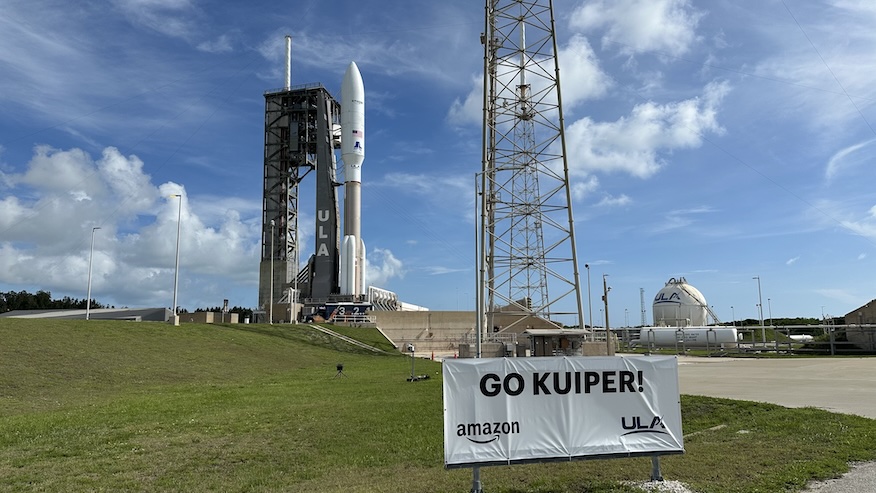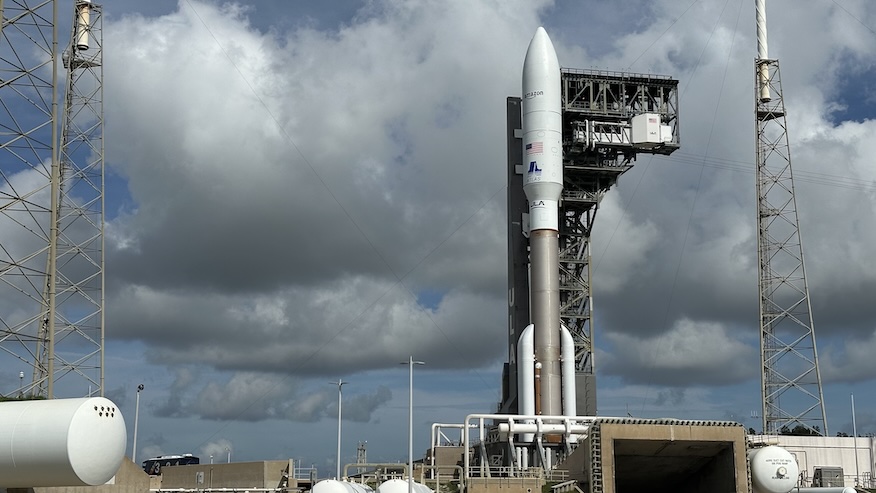
June 16, update EDT at 1 pm: Ula scrubbed the mission on the booster due to the issue of temperature connected to the RD-180 engine.
The United Launch Alliance and its customer, Amazon, will have to wait long for a long time for the second launch of Amazon's project Kuper satellites after a scrub on Monday afternoon.
During the vomiting count, Ula President and CEO Tory Bruno mentioned in a post on Bluuski that the teams “a temperature measurement compared to the previous family (which) was hot,” the other atlas 5 means compared to the launch.
The Ula called the scrub on Monday at 1 pm before the EDT employed about half an hour before the employed lift time on Monday.
“United Launch Alliance Atlas 5551 is delayed by Amazon's second project Kuper Mission, Kuper 2, being delayed by an engineering observation of a high -payed temperature within the booster engine,” the company wrote in a statement. “The team will evaluate hardware, and we will release a new launch date when available.”
The fuel for a 205 -foot long (62.5 m) rocket was concluded before the scrub call. Bruno said in another post to Blussky that the issue with gaseous nitrogen could not be decided within their available launch window.
Bruno said, “We will sort it and come back.” It is not clear whether the ULA will be able to fix on the pad or if the teams will need to return the rocket in the vertical integration facility (VIF) about a third of a mile from the pad to do the necessary task.
https://www.youtube.com/watch?v=vd9szwzdf8
On Sunday, the 45th weather squadron estimates the possibility of 75 percent for a favorable weather conditions at the time of launch, linging only cumylas clouds and concerns for minimal solar activity.
Weather officials wrote, “The high pressure of the surface in the east will maintain the southeastern flow in the spaceport during the primary and back-up launch opportunities.” “In this regime, there may be talk of shower and thunder with rain and thunder throughout the region throughout the region. However, high pressure and dry air near the region can help limit shower and thunderstorms at the beginning of the week.”
A launch Ready Review held on Friday, June 13, and Ula Launch Director James Vehicles, was overseen, concluded in a 'Go' for the launch campaign to move forward. The weather conditions improved slightly since Friday's approach.
Ula rocked his Atlas 5 rocket from VIF on a trip to a third of a mile for the launch pad on Saturday. Launch teams spent a part of the day to load a rocket -grade kerosene, RP -1 on the rocket in preparation for fuel on the launch day.

The rocket bears the Ula designation of AV-105 and will launch the 103rd of Atlas 5 rocket. The ULA mission refers to the Atlas 5 Kuper 2 or simply Kuper 2.
The launch will later be followed by a pair of national security missions using the company's vulcan rocket in this summer and then the ULA planned to launch its first batch of cuper satellites on the vulcan rocket from Cape Canverals. Unlike Vulcan 27, 45 cuper satellites can be sent to Leo that Atlas 5 can support 5 rockets.
After Monday's planned launch, ULA will have six and Atlas 5 rockets purchased by Amazon to fly satellites for their constellations. Tech veteran bought a total of nine, but one of them was used only on a dedicated mission, which was fully performed for Kuper satellites.
Make a rhythm
Amazon is against a regulatory clock to get its satellites in the classroom and in a working constellation. It is required by its agreement with the Federal Communications Commission (FCC) to achieve at least half of the first generation of its employed constellations of over 3,200 satellites in operation by the end of July 2026.
In addition to the remaining Atlas 5 rockets at its disposal, Amazon also bought 38 vulcan rockets, 18 Ariane 6 rockets, 12 new glenn rockets (with another 15 adding option) and three Falcon 9 rockets respectively from Ula, Arianspace, Blue Oralsine and Spacex.
When it announced the purchase of Falcon 9 flights from SpaceX, Amazon said in December 2023 that it would start launching on this rocket in mid -2012. Since then, Amazon has not commented on whether it is still at speed with satellite production or delivery to complete that date.
Both Blue Origin and ArianSpace have not discussed their launch manifest in public settings on a large scale, but the two companies are targeting for their next launch in the August deadline nor will the project be with the project Kuper satellites on the board. It is not clear that when the first cuper launch will be with those rockets.
Take a look at it @Ulalaunch The clip of the first cuper satellites is being released in the orbit of the Earth, which is about 280 miles from the planet. The launch is followed by deployment over a period of 15 minutes, with satellites releasing three at a time from the dispenser system. pic.twitter.com/bz1Zuy3ivs
– Project Kuper (@Projectkuiper) 2 May, 2025
It created a new page on its website on June 10, 2025, stating that it included “recent and upcoming project Kuper Mission.” Until June 15, the page did not include references for any other launch, which was designated as KA-02 and already launched Ka-01, which was removed on 28 April.
“Ula will deploy satellites at an altitude of 280 miles (450 km) above the Earth, at the point at which the project Kuper Team Redmund, will command the mission from our 24/7 Mission Operations Center in Washington, Washington, Satellite confirms health, and eventually grows its unconnected arbits of 392 miles (630 km).
This second flight to Amazon is a Lagi to its constellation to 54 satellites, which requires a little more than a year over a year for more than 1,600. One in Post On LinkedIn, Rajiv Badyal, vice -president of technology at Project Kuper, said the April launch made him optimistic about the company's direction.
“The success of the Kuper Mission on our first full scale in April meant that we could immediately go to our next launch,” Baddal wrote. “All 27 satellites for our KA-02 mission were fully integrated within 17 days of that first launch, and Ula planned to send them to class next Monday. Thank you for the entire team for quick turnout.
An important test for Amazon will be how soon it can return to the pad with its satellites, which rockets will be ready to blow them.
Discover more from Daily Hind News
Subscribe to get the latest posts sent to your email.



